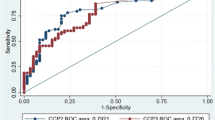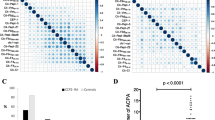Abstract
We evaluated the diagnostic value of anti-cyclic citrullinated peptide 2 (anti-CCP2) antibodies and other potential diagnostic biomarkers (IgM rheumatoid factor, anti-agalactosyl IgG antibodies, matrix metalloproteinase 3, C-reactive protein) for predicting early development of rheumatoid arthritis (RA). Patients were defined as having recent-onset undifferentiated arthritis (UA) if they had developed arthritis in two or more joints within the previous 2 years and could not be classified with a well-defined arthropathy. Baseline levels of biomarkers were measured in blood samples collected at the entry of the study and the patients were followed for 1 year to monitor development of RA. Diagnoses of RA and non-RA arthropathies were made according to individual standard diagnostic criteria. A total of 146 patients were enrolled in the study. In the follow-up year, 18 patients developed RA, 54 developed non-RA arthropathies, and 60 remained in the UA category. The sensitivity and specificity of the presence of anti-CCP2 antibodies for the diagnosis of RA were 83.3 and 93.0%, respectively. The positive predictive value (PPV), negative predictive value (NPV), and diagnostic accuracy of anti-CCP2 antibodies for RA (65.2, 97.2, and 91.7%, respectively) were higher than for any other biomarker. Combination of anti-CCP2 with any other biomarker only slightly improved each diagnostic value compared to the presence of anti-CCP2 alone. Among the anti-CCP2-positive patients, the average titer was significantly higher in those with RA than in non-RA or UA patients (163.7 ± 138.4 vs 55.2 ± 72.0 U/ml, p = 0.017). Anti-CCP2 antibodies are superior to any other single biomarker for predicting early development of RA in patients with recent-onset UA and the diagnostic value of anti-CCP2 alone is similar to that for biomarker combinations. Moreover, the anti-CCP2 antibody titer is useful to discriminate between patients at high risk for early developing RA from those at risk of developing non-RA arthropathies.


Similar content being viewed by others
References
Pincus T, Callahan LF, Sale WG, Brooks AL, Payne LE, Vaughn WK (1984) Severe functional declines, work disability, and increased mortality in seventy-five rheumatoid arthritis patients studied over nine years. Arthritis Rheum 27:864–872
Scott DL, Symmons DP, Coulton BL, Popert AJ (1987) Long-term outcome of treating rheumatoid arthritis: results after 20 years. Lancet 1:1108–1111
Bukhahari M, Harrison B, Lunt M, Scott DGI, Symmons DPM, Silman AJ (2001) Time to first occurrence of erosions in inflammatory polyarthritis: results from prospective community-based study. Arthritis Rheum 44:1248–1253
Quinn MA, Conaghan PG, Emery P (2001) The therapeutic approach of early intervention for rheumatoid arthritis: what is the evidence? Rheumatology (Oxford) 40:1211–1220
Mottonen T, Hannonen P, Korpela M, Nissila M, Kautiainen H, Ilonen J et al (2002) Delay to institution of therapy and induction of remission using single-drug or combination-disease-modifying antirheumatic drug therapy in early rheumatoid arthritis. Arthritis Rheum 46:894–898
O’Dell JR (2002) Treating rheumatoid arthritis early: a window of opportunity? Arthritis Rheum 46:283–285
Landewe RB (2003) The benefits of early treatment in rheumatoid arthritis: confounding by indication, and the issue of timing. Arthritis Rheum 48:1–5
Landewe RB, Boers M, Verhoeven AC, Westhovens R, van de Laar MA, Markusse HM et al (2002) COBRA combination therapy in patients with early rheumatoid arthritis: long-term structural benefits of a brief intervention. Arthritis Rheum 46:347–356
Arnett FC, Edworthy SM, Bloch DA, McShane DJ, Fries JF, Cooper NS et al (1988) The American Rheumatism Association 1987 revised criteria for the classification of rheumatoid arthritis. Arthritis Rheum 31:315–324
van Venrooij WJ, Hazes JM, Visser H (2002) Anticitrullinated protein/peptide antibody and its role in the diagnosis and prognosis of early rheumatoid arthritis. Neth J Med 60:383–388
Lisse JR (1993) Does rheumatoid factor always mean arthritis? Postgrad Med 94:133–134, 139
Schellekens GA, Visser H, de Jong BA, van den Hoogen FH, Hazes JM, Breedveld FC et al (2000) The diagnostic properties of rheumatoid arthritis antibodies recognizing a cyclic citrullinated peptide. Arthritis Rheum 43:155–163
Young A, Sumar N, Bodman K, Goyal S, Sinclair H, Roitt I, Isenberg D (1991) Agalactosyl IgG: an aid to differential diagnosis in early synovitis. Arthritis Rheum 34:1425–1429
Yamanaka H, Matsuda Y, Tanaka M, Sendo W, Nakajima H, Taniguchi A, Kamatani N (2000) Serum matrix metalloproteinase 3 as a predictor of the degree of joint destruction during the six months after measurement, in patients with early rheumatoid arthritis. Arthritis Rheum 43:852–858
Visser H, le Cessie S, Vos K, Breedveld FC, Hazes JM (2002) How to diagnose rheumatoid arthritis early: a predication model for persistent (erosive) arthritis. Arthritis Rheum 46:357–365
Hochberg MC (1997) Updating the American College of Rheumatology revised criteria for the Classification of systemic lupus erythematosus [letter]. Arthritis Rheum 40:1725
Vitali C, Bombardieri S, Moutsopoulos HM, Balestrieri G, Bencivelli W, Bernstein RM et al (1993) Preliminary Criteria for the classification of Sjogren’s syndrome. Arthritis Rheum 36:340–347
Yamaguchi M, Ohta A, Tsunematsu T, Kasukawa R, Mizushima Y, Kashiwazaki H et al (1992) Preliminary criteria for classification of Adult Onset Still’s Disease. J Rheumatol 19:424–4730
Hunder GG, Arend WP, Bloch DA, Calabrese LH, Fauci AS, Fries JF et al (1990) The American College of Rheumatology 1990 criteria for the classification of vasculitis. Arthritis Rheum 33:1065–1144
Bird HA, Esselinckx W, Dixon AStJ, Mowat AG, Wood PHN (1979) An evaluation of criteria for polymyalgia rheumatica. Ann Rheum Dis 38:434–439
Bohan A, Peter JB (1975) Polymyositis and dermatomyositis. New Engl J Med 13:344–346
Amor B, Dougados M, Mijiyama M (1990) Criteres de classification des spondylarthropathies. Rev Rheum 55:85–89
Pasero G, Barbieri P (1986) Palindromic rheumatism: you just have to think about it! Clin Exp Rheumatol 4:197–199
Jansen AL, van der Horst-Bruinsma I, van Schaardenburg D, van de Stadt RJ, de Koning MH, Dijkmans BA (2002) Rheumatoid factor and antibodies to cyclic citrullinated peptide differentiate rheumatoid arthritis from undifferentiated polyarthritis in patients with early arthritis. J Rheumatol 29:2074–2076
Rantapää-Dahlqvist S, de Jong BA, Berglin E, Hallmans G, Wadell G, Stenlund H et al (2003) Antibodies against cyclic citrullinated peptide and IgA rheumatoid factor predict the development of rheumatoid arthritis. Arthritis Rheum 48:2741–2749
Suzuki A, Yamada R, Chang X, Tokuhiro S, Sawada T, Suzuki M et al (2003) Functional haplotypes of PADI4, encoding citrullinating enzyme peptidylarginine deiminase 4, are associated with rheumatoid arthritis. Nat Genet 34(4):395–402
Yamamoto K, Yamada R (2005) Genome-wide single nucleotide polymorphism analyses of rheumatoid arthritis. J Autoimmun 25(Suppl):12–15
Takizawa Y, Suzuki A, Sawada T, Ohsaka M, Inoue T, Yamada R et al (2006) Citrullinated fibrinogen detected as a soluble citrullinated autoanigen in rheumatoid arthritis synovial fluids. Ann Rheum Dis 65:1013–1020
Forslind K, Ahlmen M, Eberhardt K, Hafström I, Svensson E (2004) Prediction of radiological outcome in early RA in clinical practice: role of antibodies to citrullinated peptide (anti-CCP). Ann Rheum Dis 63:1090–1095
Kastbom A, Strandberg G, Lindroots A, Skogh T (2004) Anti-CCP antibody test predicts the disease course during three years in early rheumatoid arthritis (the TIRA project). Ann Rheum Dis 63:1085–1089
van Gaalen FA, van Aken J, Huizinga TW, Schreuder GM, Breedveld FC, Zanelli E et al (2004) Association between HLA class II genes and autoantibodies to cyclic citrullinated peptides (CCP) affects severity of rheumatoid arthritis. Arthritis Rheum 50:2113–2121
Lindqvist E, Eberhardt K, Bendtzen K, Heinegard D, Saxne T (2004) Prognostic laboratory markers of joint damage in rheumatoid arthritis. Ann Rheum Dis 64:196–201
van Jaarsveld CH, ter Borg EJ, Jacobs JW, Schellekens GA, Gmelig-Meyling FH, van Booma-Frankfort C et al (1999) The prognostic value of the antiperinuclear factor, anti-citrullinated peptide antibodies and rheumatoid factor in early rheumatoid arthritis. Clin Exp Rheumatol 17:689–697
Kroot EJ, de Jong BA, van Leeuwen MA, Swinkels H, van den Hooge, van’t Hof MA et al (2000) The prognostic value of anti-cyclic citrullinated peptide antibody in patients with recent-onset rheumatoid arthritis. Arthritis Rheum 43:1831–1835
Jansen LM, van Schaardenburg D, van der Horst-Bruinsma IE, van de Stadt RJ, de Koning MHM, Dijkmans BA (2003) The predictive value of anti-cyclic citrullinated peptide antibodies in early arthritis. J Rheumatol 30:1691–1695
Meyer O, Labarre C, Dougados M, Goupille P, Cantagrel A, Dubois A et al (2003) Anticitrullinated protein/peptide antibody assays in early rheumatoid arthritis for predicting five year radiographic damage. Ann Rheum Dis 62:120–126
Vencovsky J, Machacek S, Sedova L, Kafkova J, Gatterrova J, Pesakova V, Ruzickova S (2003) Autoantibodies can be prognostic markers of an erosive disease in early rheumatoid arthritis. Ann Rheum Dis 62:427–430
Bas S, Genevay S, Meyer O, Gabay C (2003) Anti-cyclic citrullinated peptide antibodies, IgM and IgA rheumatoid factors in the diagnosis and prognosis of rheumatoid arthritis. Rheumatology (Oxford) 42:677–680
Saraux A, Berthelot JM, Devauchelle V, Bendaoud B, Chales G, Le Henaff C et al (2003) Value of antibodies to citrulline-containing peptides for diagnosing early rheumatoid arthritis. J Rheumatol 30:2535–2539
Nielen MM, van Schaardenburg D, Reesink HW, van de Stadt RJ, van der Horst-Bruinsma IE, de Koning MH et al (2004) Specific autoantibodies precede the symptoms of rheumatoid arthritis. Arthritis Rheum 50:380–386
Acknowledgments
This work was supported by a Grant-in-Aid for Research on Immunological Disorders from the Japan National Hospital Organization.
Author information
Authors and Affiliations
Corresponding author
Rights and permissions
About this article
Cite this article
Kudo-Tanaka, E., Ohshima, S., Ishii, M. et al. Autoantibodies to cyclic citrullinated peptide 2 (CCP2) are superior to other potential diagnostic biomarkers for predicting rheumatoid arthritis in early undifferentiated arthritis. Clin Rheumatol 26, 1627–1633 (2007). https://doi.org/10.1007/s10067-007-0558-5
Received:
Revised:
Accepted:
Published:
Issue Date:
DOI: https://doi.org/10.1007/s10067-007-0558-5




